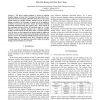Free Online Productivity Tools
i2Speak
i2Symbol
i2OCR
iTex2Img
iWeb2Print
iWeb2Shot
i2Type
iPdf2Split
iPdf2Merge
i2Bopomofo
i2Arabic
i2Style
i2Image
i2PDF
iLatex2Rtf
Sci2ools
ASPDAC
2009
ACM
2009
ACM
Timing driven power gating in high-level synthesis
- The power gating technique is useful in reducing standby leakage current, but it increases the gate delay. For a functional unit, its maximum allowable delay (for a target clock period) limits the smallest standby leakage current its power gating can achieve. In this paper, we point out: in the high-level synthesis of a non-zero clock skew circuit, the resource binding (including functional units and registers) has a large impact on the maximum allowable delays of functional units; as a result, different resource binding solutions have different standby leakage currents. Based on that observation, we present the first work to draw up the timing driven power gating in high-level synthesis. Given a target clock period and design constraints, our goal is to derive the minimum-standby-leakage-current resource binding solution. Benchmark data show: compared with the existing design flow, our approach can greatly reduce the standby leakage current without any overhead.
Related Content
| Added | 28 May 2010 |
| Updated | 28 May 2010 |
| Type | Conference |
| Year | 2009 |
| Where | ASPDAC |
| Authors | Shih-Hsu Huang, Chun-Hua Cheng |
Comments (0)

